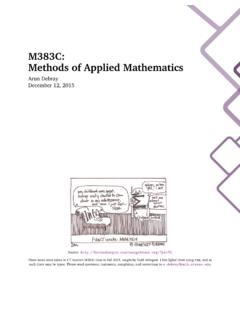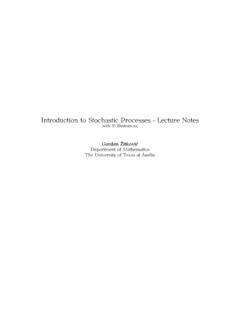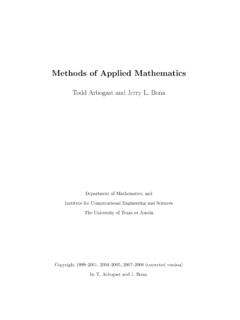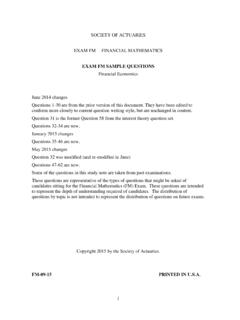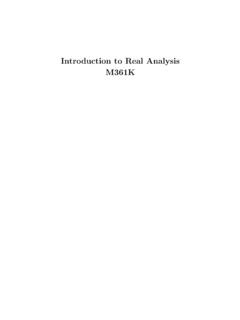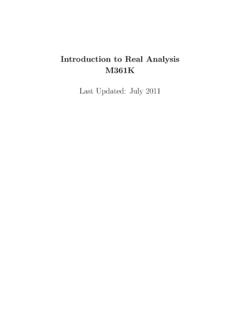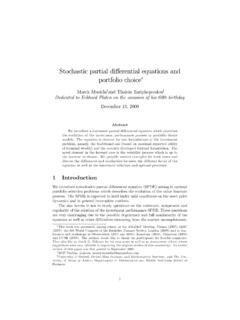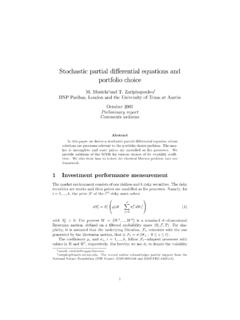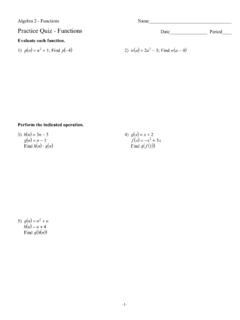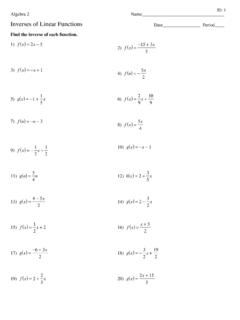Transcription of Domain, Range, and Period of the three main trigonometric ...
1 Domain, Range, and Period of the three main trigonometric (x) Domain:R= ( , ) Range: [ 1,1] Period : 2 (x) Domain:R Range: [ 1,1] Period : 2 (x) Domain:{x|x6= 2+k ,k=.., 1,0,1,..}={x|x6=.., 3 2, 2, 2,3 2,..} Range:R Period : Domain, Range, and Definition of the three main inverse trigonometric 1(x) Domain: [ 1,1] Range: [ 2, 2] Definition: =sin 1(x) meanssin( ) =xwhen 1 x 1 and 2 1(x) Domain: [ 1,1] Range: [0, ] Definition: =cos 1(x) meanscos( ) =xwhen 1 x 1 and 0 1(x) Domain:R Range: ( 2, 2) Definition.
2 =tan 1(x) meanstan( ) =xwhen 2< < (sin 1(x)) =xwhen 1 x 1(sin(x)) =xwhen 2 x Isin(sin 1(1/2)) = 1/2, since 1 1/2 1 Bad Isin(sin 1( )) = undefined, since < 1 Good II: is in the right quadrant, and written correctlysin 1(sin( 5)) = 5, since 2 5 2 Bad II: is in the right quadrant, but written incorrectlysin 1(sin(9 5)) =?Now9 5is not between 2and 2, but itisin the right quadrant, namely quadrantIV. To find the correct angle, simply add or subtract 2 from the angle given untilyou get an angle in the range ofsin 1(x).
3 In this case,9 5 2 = 5, sosin 1(sin(9 5)) = II: is in the wrong quadrantsin 1(sin(6 5)) =?Here is actually in the wrong quadrant, so we need to flip it across theyaxis andfind the associated angle in the right quadrant. You can just look at the picture andsee that 5is the correct angle, sosin 1(sin(6 5)) = (cos 1(x)) =xwhen 1 x 1(cos(x)) =xwhen 0 x .Good Icos(cos 1( 1/3)) = 1/3, since 1 1/3 1 Bad Icos(cos 1( 3)) = undefined, since 1< 3 Good II: is in the right quadrant, and written correctlycos 1(cos(4 5)) =4 5, since 0 4 5 Bad II: is in the right quadrant, but written incorrectlycos 1(cos( 6 5)) =?
4 Now 6 5is not between 0 and , but itisin the right quadrant, namely quadrantII. To find the correct angle, simply add or subtract 2 from the angle given untilyou get an angle in the range ofcos 1(x). In this case, 6 5+ 2 =4 5, socos 1(cos( 6 5)) =4 II: is in the wrong quadrantcos 1(cos(6 5)) =?Here is actually in the wrong quadrant, so we need to flip it across thexaxis andfind the associated angle in the right quadrant. You can just look at the picture andsee that4 5is the correct angle, socos 1(cos(6 5)) =4 (tan 1(x)) =xwhen < x <.
5 1(tan(x)) =xwhen 2< x < Itan(tan 1( 1000)) = 1000, since < 1000< Bad ITHERE IS NO BAD I FOR INVERSE TANGENT. Case I always works!NOTE:Now there are some serious discrepancies between Sin, Cos, and Tan. The way tothink of this is that even if is not in the range oftan 1(x), it isalwaysin the rightquadrant. So there is only Good II and Bad II, no Worse II. That means the only thingthat can go wrong is that the angle was not written II: is written correctlytan 1(tan( 5)) = 5, since 2< 5< 2 Bad II: is written incorrectlytan 1(tan(6 5)) =?
6 Now6 5is not between 2and 2, so just like with the Bad II for Sin and Cos, I addor subtract the Period until I get an angle thatisin the range oftan 1(x). For Sinand Cos, I add or subtract 2 because that is their Period . For Tan, I add or subtract , the Period oftan(x). Here6 5 = 5, sotan 1(tan(6 5)) = II: is in the wrong quadrantTHERE IS NO WORSE II FOR INVERSE TANGENT. Only Good II and Bad

